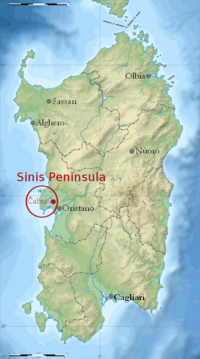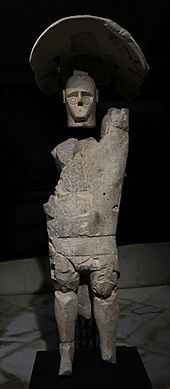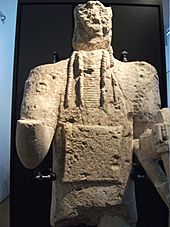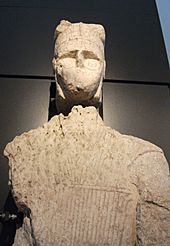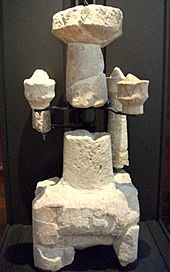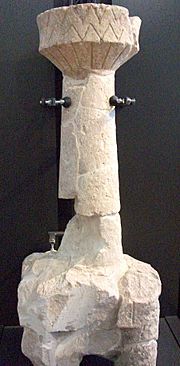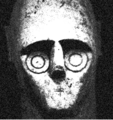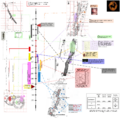Giants of Mont'e Prama facts for kids
|
Giganti di Mont'e Prama
Zigantes de Mont'e Prama |
|
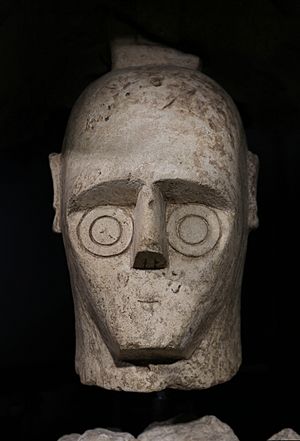
Giant head from Mont'e Prama
|
|
| Lua error in Module:Location_map at line 420: attempt to index field 'wikibase' (a nil value). | |
| Location | Cabras, Province of Oristano, Italy |
|---|---|
| Region | Sinis peninsula, Sardinia |
| Type | Sculptures |
| Part of | Heroon, Giants' grave, Necropolis (debated) |
| Area | ≈ 75000 m2 |
| Height | 2.5 metres (8 ft 2 in) |
| History | |
| Builder | Nuragic Sardinians |
| Material | limestone |
| Founded | Between the 11th and the 8th century BC (debated) |
| Abandoned | Late 4th century BC – first decades of the 3rd century BC |
| Periods | Iron Age I |
| Cultures | Nuragic civilisation |
| Associated with | Nuragic aristocrats |
| Events | Sardo–punic wars (debated) |
| Site notes | |
| Excavation dates | 1974: G. Atzori; 1975: A. Bedini; 1977: G. Lilliu, G. Tore, E. Atzeni; 1977: G. Pau, M. Ferrarese Ceruti – C. Tronchetti |
| Condition | Sculptures restored at the Centro di restauro e conservazione dei beni culturali of Li Punti (Sassari) — Necropolis not yet fully excavated |
| Ownership | Public |
| Public access | Yes |
Imagine finding giant stone statues buried in a field! That's what happened in March 1974 in Sardinia, Italy. These amazing ancient stone sculptures are called the Giants of Mont'e Prama. They were made by the Nuragic civilization, a group of people who lived in Sardinia long ago.
The statues were found in many broken pieces near Mont'e Prama, a low hill. They are carved from local sandstone and stand between 2 and 2.5 meters tall. That's like two grown-ups standing on top of each other!
After they were found, archaeologists worked hard to dig up about five thousand pieces. This included fifteen heads and twenty-two bodies. For thirty years, these pieces were kept safe in a museum in Cagliari. Some of the most important parts were even put on display.
Along with the statues, archaeologists also found large models of nuraghe buildings. Nuraghes were ancient stone towers built by the Nuragic people. They also found special sacred stones called baetyls.
Since 2007, experts have been carefully putting the pieces back together. So far, twenty-five statues have been restored. These include warriors, archers, and boxers. Thirteen nuraghe models have also been put back together. You can see these incredible restored statues at special exhibitions.
Archaeologists believe there were originally forty-four statues in total. Once all the restoration is finished, most of these finds will go back to Cabras to be shown in a local museum.
The statues are very old, possibly made between the 11th and 8th centuries BC. If this is true, they would be some of the oldest human-shaped sculptures in the Mediterranean area, even older than the famous Greek statues called kouroi!
Contents
Ancient Art in Sardinia
Early Stone Art
Long before the Giants of Mont'e Prama, people in Sardinia were already making sculptures. The oldest known example is a small human-like figure called the Venus of Macomer. It might be from as far back as 6000-4000 BC!
Later, the Ozieri culture made many small, detailed figures of a Mother Goddess. One famous example is the idol of Perfugas, which shows a goddess feeding her child.
Warrior Figures and Sacred Stones
As time went on, the art changed. During the Eneolithic period (Copper Age), people made "statue-menhirs." These were tall stones carved to look like people, often with a 'T'-shaped face and symbols.
Later, during the Bronze Age, the Nuragic people started carving symbols and faces onto sacred stones called baetyls. These stones were often found in special places like giants' graves.
Archaeologists believe that these earlier carvings helped lead to the creation of the large, human-shaped statues of Mont'e Prama. The Nuragic people were very skilled at working with stone. They built amazing sacred wells and giant tombs using advanced techniques. This shows they had the talent to create the Giants.
Where the Giants Were Found
Most of the statue pieces were found scattered over a burial ground (called a necropolis) on the slopes of Mont'e Prama. This hill is in the middle of the Sinis peninsula. Another piece, a human head, was found about 2 kilometers away near a sacred well.
Because of where the pieces were found, experts think the statues were originally placed either near this burial ground or somewhere else important in the Sinis peninsula. This area was very important in ancient times. It was a busy trading spot and had many Nuragic settlements.
The Sinis peninsula was also close to Montiferru, a region with ancient iron and copper mines. This made it a valuable area for the Nuragic people.
What the Statues Look Like
The Giants of Mont'e Prama are very unique. They are tall, between 2 and 2.5 meters. Their faces have a special 'T'-shape, with big noses and eyes shown as two circles. Their mouths are just a short line.
The statues represent three types of figures: boxers, archers, and warriors. They all stand straight, barefoot, with their legs slightly apart. Their bodies are often decorated with zig-zag patterns, lines, and circles. Even their hair is shown with carved patterns.
It's thought that these statues were once painted with bright colors! Traces of red have been found on an archer's chest, and black on other pieces.
Boxers
The "boxers" are the most common type of statue found. They are called boxers because they wear a special glove-like weapon on their right arm, similar to a cestus. They also hold a curved, rectangular shield above their head with their left arm.
These boxers are shown bare-chested, wearing loincloths. Their heads are covered by smooth caps. It's believed they were taking part in sacred games or funeral games to honor the dead.
Archers
Five archer statues have been put back together. They wear short tunics and a square chest plate. Their left arm holds a bow, and their right hand is often stretched forward, like they are greeting someone.
Their legs are protected by special leg guards. The details on their weapons are very clear. They have a quiver (for arrows) sculpted on their back. Their heads are protected by a helmet with a crest and horns.
Warriors
Only a few warrior statues have been found. They are different from the archers because of their clothing and armor. The best-preserved warrior has a special "envelope-shaped" helmet with a crest and horns.
This warrior also wears armor with vertical stripes, which might have been made of metal strips on tough leather. Their shield is round and has detailed patterns.
Nuraghe Models
Nuraghes were huge stone towers and castles built by the Nuragic people. They were some of the tallest stone buildings in the Bronze Age, after the Egyptian pyramids!
Nuraghe models are smaller versions of these towers. They were likely used for sacred or political reasons. Mont'e Prama has the most nuraghe models found at any archaeological site. Experts have put together five models of complex nuraghes (with many towers) and twenty models of simple, single-towered nuraghes.
These models are quite large, up to 1.4 meters tall for the complex ones. They show amazing details of the real nuraghes, including platforms and staircases.
Sacred Baetyls
"Baetyls" are sacred stones, often simple in shape. The word might come from an ancient word meaning "house of God." For the Nuragic people, these stones probably represented a god or a god's home. They are often found in religious places and giant tombs.
At Mont'e Prama, truncated cone-shaped baetyls with holes were found. Some scholars think these holes might represent the eyes of a god, watching over the tombs. These baetyls show that the Nuragic people wanted to connect with their ancient traditions.
The Discovery and Excavations
The first piece of a statue, a fragmented head, was found in 1965 near a sacred well. But it wasn't until March 1974 that the main discovery happened. Two farmers, Sisinnio Poddi and Battista Meli, were preparing their land for planting when they kept finding stone pieces.
They didn't realize how important these pieces were at first. But the landowner, Giovanni Corrias, saw a pile of stones with a giant head and knew it was special. He quickly told the authorities.
Sadly, the site was not protected at first, and some pieces, especially heads, were stolen. Later, the area was bought, and proper archaeological digs began. Many archaeologists have worked on the site, carefully uncovering and studying the finds.
When Were the Statues Made?
One of the biggest questions about the Giants of Mont'e Prama is exactly when they were made. Different experts have different ideas, ranging from the 10th to the 8th century BC. This was a time of big changes for the Nuragic civilization.
Scientists use a method called carbon-14 dating to find out how old things are. They have tested bone remains from the tombs at Mont'e Prama. Some of the oldest burials date back to around 1246 BC. This suggests that the statues might be older than first thought.
Archaeologists also compare the statues to smaller bronze figures made by the Nuragic people. These "bronze statuettes" look very similar to the Giants. This close link suggests that the statues and the bronze figures were made around the same time.
Another clue is an Egyptian scarab found in one of the tombs. This small beetle-shaped artifact is from the Egyptian New Kingdom. While scarabs can be tricky for dating because they might have been kept for a long time, this one helps connect the site to a wider ancient world.
Pottery found at the site also helps with dating. Some of the pottery suggests that the burial ground started around 1250 BC, in the Late Bronze Age. This means the site, and possibly the statues, are very ancient.
Why Were They Built?
Experts believe the Mont'e Prama complex was a way for the Nuragic leaders to show off their power and honor their brave warriors. Its location, facing the sea, might have been a message to foreign visitors, especially the Phoenicians who were settling in Sardinia, that the Nuragic people were strong and in charge.
The nuraghe models found with the statues could be symbols of Nuragic identity and power. They might also have been sacred symbols, acting as guardians for the dead or as part of rituals. This shows how important the nuraghe buildings were to their culture.
Some scholars think the statues were built during a time when the Nuragic society was changing, perhaps due to the arrival of the Phoenicians. However, other experts believe the statues show a time of great cultural change and strength for the Nuragic people, not a decline. They see the statues as a unique example of Nuragic art and power.
The exact meaning and purpose of the Giants of Mont'e Prama are still being debated by scholars. But one thing is clear: these statues are an incredible window into the rich and complex history of the ancient Nuragic civilization.
Images for kids
-
Upper left, Filitosa (Corsica): Nuragic Torrean civilization, stelae with human head in relief. — Upper right, Viddalba (Sardinia): Nuragic civilization, warrior with crested helmet. — Lower left, Filitosa: Nuragic torrean civilization, stelae with human head and sword in relief. — Lower right, Baunei (Sardinia): Nuragic civilization, baetylus with human head in relief.
-
Decimoputzu, nuragic bronze with crested helmet like Philistines prisoners of Medinet Habu, probably the Sardus Pater Babai
-
Nuragic bronze boxer warrior with oblong shield above his head, from Dorgali, National Archaeological Museum of Cagliari.
-
Bronze nuraghe model from Olmedo, Sassari, Sanna Museum
-
Alghero, nuraghe Palmavera: Nuragic tron or altar
-
Nuragic iron compass, from nuraghe Fontana (Ittireddu), Sanna Museum, Sassari
See also
 In Spanish: Gigantes del mont'e Prama para niños
In Spanish: Gigantes del mont'e Prama para niños
- History of Carthage
- History of Sardinia
- Late Bronze Age collapse
- Nuragic bronze statuettes
- Nuragic civilization
- Sea Peoples
- Tharros


